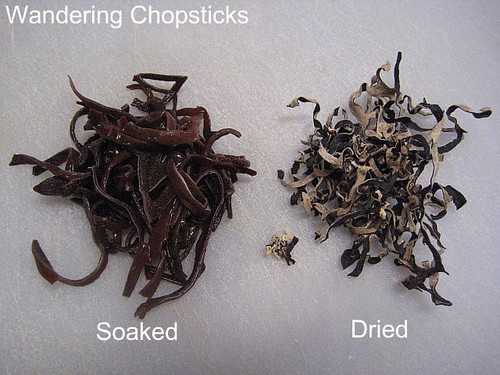
Tree/wood ear fungus/mushroom, called nam meo in Vietnamese, is a popular ingredient in Chinese and Vietnamese cooking. Although it is sometimes referred to as a mushroom, it is a fungus that grows on trees. Nutritionally, it has anticoagulent properties and helps prevent blood in feces, hemorrhaging, and excessive menstrual flow. It is inexpensive and is often sold dried, whole or in strips (like what you see in the picture).
To reconstitute it, simply soak in warm water for about 15 minutes. Cut off any hard ends from the base. I like using pre-cut wood ear fungus for ease.
Tree ear fungus has little flavor but provides plenty of crunch despite different cooking methods. That's why it's prized in soups, egg rolls, or when used in stuffing.
Some of my recipes that use tree ear fungus include:
Canh Bi/Bau Nhoi Thit (Vietnamese Pork-Stuffed Winter Melon Soup)
Cha Gio/Nem Ran (Vietnamese Spring/Egg Rolls)
Cha Gio Bap/Ram Bap (Vietnamese Corn Egg Rolls)
Hot and Sour Soup

This stuff was an answer (a question?) on Jeopardy the other night!
ReplyDeleteI love the texture of wood ear!
ReplyDeleteamy,
ReplyDeleteI guess that makes this pretty mainstream then.
Cindy,
Me too!
Hi, I love your Blog and I am using your recipe to make Cha Gio for the first time. I would like to ask you if I have the right ingredient for the wood ear mushroom. The bag I bought at my local Asian market is made by "Asian Taste" and made in China. It is labeled as Dried Black Fungus Sliver and Nam Treo Trang. Is this the right one? The "Trang" at the end makes me unsure but they look like the ones in your photo. Thanks. -Eric
ReplyDeleteEric,
ReplyDeleteThe "trang" makes me think it's the dessert white cloud fungus. But if you say it looks like my photo, then it should be the right kind? Even if it's not, the white fungus is good for you and is crunchy too.
Thanks, WC, and I agree, since they look exactly like your photo, black on one side and like suede on the other. I'm anxious to see how they look when soaked in water. At the market there was a section of them whole, and section of them already chopped, so that makes me even more certain. It's my guess that there was simply a Chinese to Vietnamese translation error with the label. I'm really excited to have your great recipe and procedure to follow and can't wait to give it a try. I've made hundreds of lumpia, since I grew up with Filipino neighbors, but I've never tried Vietnamese cooking until now. I will be learning it all from your blog. Thanks so much. -Eric
ReplyDeleteHow did it go?
DeleteThey turned out perfectly! I need to make these again.
DeleteEric,
ReplyDeleteGreat! I'm glad my blog got you to try Vietnamese cooking. Let me know how it goes.
I've learned a lot about cooking from my Vietnamese son-in-law. Now I can learn from you. It's always good to have two points of view.
ReplyDeleteMrhycannon,
ReplyDeleteSure, there's lots of info out there to help you explore Vietnamese cuisine.